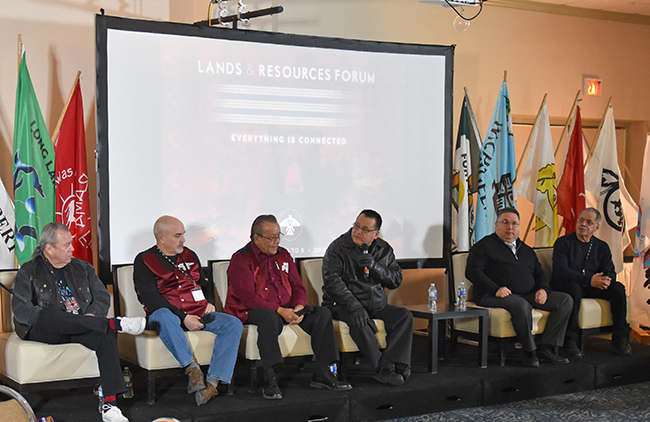Anishinabek leadership calls for consultation for successful partnerships

By Kelly Anne Smith
NORTH BAY – “They have to talk to us right from the start, right from phase one of the project. “ This from Grand Council Chief Patrick Madahbee at the 2018 Anishinabek Nation Lands and Resources Forum.
Grand Council Chief Patrick Madahbee welcomed participants from First Nations, government, industry and academia to focus on treaty rights as they discussed lands and resources. The three-day event took place recently at the Best Western in North Bay on the traditional lands of Nipissing First Nation. It started with an opening ceremony from Evelyn McLeod and Mother Earth Drum by High Ridge Singers.
The forum’s theme was “Everything is Connected.” Sharing circles with First Nations and representatives from the Ministry of Environment and Change, The Ministry of Natural Resources and Forestry, and the Ministry of Transportation encouraged progressive discussion.
The leadership session included Grand Council Chief Patrick Madahbee, Deputy Grand Chief Glen Hare, Regional Grand Chief Pierre Pelletier; Regional Grand Chief James Marsden, Regional Grand Chief Paul Eshkakogan, and Biinjitiwaabik Zaaging Anishinaabek Chief Melvin Hardy.
Grand Council Chief Patrick Madahbee says the Anishinabek Nation is committed to conservation and the responsible use of resources but the lack of funding works against that principle. “So how do you expect partnerships? How do you expect folks to build the capacity to get into partnerships with industry without the resources to do it? We need an equitable playing field if we are going to have this talk of consultation. There are times we need to hire a biologist or perhaps an anthropologist to make an informed decision. But they want to push ahead quickly instead of smartly because of money.”
Madahbee spoke of frustrations dealing with mining companies. “The miners will tell you of these companies coming in and taking the highest-grade ore, and then they leave. They are not mining secondary minerals with the money in the high-grade ores. They come in and make a mess. Certain regulations tell them to clean up the environment again, but it’s never the same.
Deputy Grand Council Chief Glen Hare, a citizen of M’Chigeeng First Nation on Manitoulin Island, calls for government and mining companies to “Work with us.” He called for people coming onto the land to consult with leadership first. “That has to stop and that’s where relationships should begin.”
Biinjitiwaabik Zaaging Anishinaabek Chief Melvin Hardy explained how rights are tread over. “They said consultation was going on but there was no consultation with our people because the CEOs in Vancouver did not know the prospectors were making deals. They are the money makers, with the miners. We’ve got people walking around seeing these people digging up and messing up our lands.”
Hardy says there is arsenic leaching into waterways in his territory and he has warnings. “So, in the future before you move ahead, you still have to clean up the past mess. Those messes (toxic) are having a big effect on people’s lives, our brains and the development of our babies with pregnant moms having to drink the stuff while living in on our land. Politicians don’t know what it’s like to live on the land, and drink that water, and have to feel that.”
Madahbee said he finds it insulting that companies come onto the land and do whatever they want. “Companies and governments must remember there are laws in place. Their own constitution recognizes Aboriginal Treaty Rights. The United Nations Declaration on the Rights of Indigenous Peoples recognizes our rights for free, prior and informed consent. That isn’t happening.”
Madahbee says the best way forward is for companies to come to the communities to sort out all the concerns. “We need common sense talk about what we need to do to protect the environment.”


